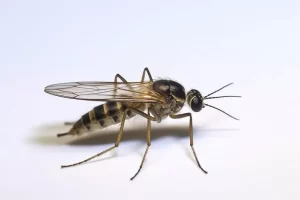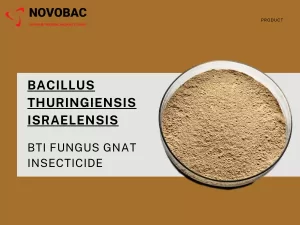For both indoor and outdoor plants, fungus gnats are a frequent issue that may rapidly turn into an unpleasant nuisance to manage. You’re not the only one who has grown weary of spotting these little flying insects about your plants. Identifying insects accurately and taking action to reduce their population are two of the most crucial parts of dealing with insects that will be covered in this article.Most importantly, we’ll show you how to get rid of fungus gnats effectively using proven methods including Bti fungus gnat insecticide.
They are prevalent in both indoor and outdoor gardening. They are tiny flying insects. These pests are sometimes mistaken for fruit flies or other small flies, but they stand out thanks to characteristics like their long legs and black or dark grey bodies. The white, legless larvae live normally in damp soil where they consume plant roots and other organic substances.
The adult insects have a lifespan of about one week, during which they mate and lay eggs in soil or other damp areas. Larvae can exist for several weeks after the eggs hatch before becoming pupae and emerging as adults. Although the larvae are not dangerous to people, they can destroy plant roots and limit their growth, making them a serious adversary of plants.

Gardeners usually suffer from the question as to where do they come from? They typically come from soil or other damp areas where they can lay their eggs. They thrive in moist environments, so overwatering or poor drainage can create the perfect conditions for an infestation. Once the eggs hatch into larvae, they can linger in the soil for a number of weeks while harming plant roots.
They have a short lifespan of “about one week,” during which they reproduce and lay their eggs in mud or other moist locations.Yet, they can survive for up to three weeks under ideal circumstances.
Larvae can exist for several weeks after the eggs hatch before becoming pupae and emerging as adults.Under optimal circumstances, this life cycle can be finished in as little as 17 days, which indicates that an infestation can soon become a significant issue for plants.
They may harm plant roots and bother gardeners in addition to doing so. They can fly around plants and people, and their larvae can be unsightly when they emerge from soil. Thus, it’s crucial to take action to reduce their population and avoid infestation.

Eliminate them by using multiple methods like drying soil, avoiding organics, using traps, and insecticides.
 Using a well-draining potting mix with ingredients like perlite or vermiculite can prevent waterlogging and thus, reduce the risk of pest infestation.
Using a well-draining potting mix with ingredients like perlite or vermiculite can prevent waterlogging and thus, reduce the risk of pest infestation.Mix Bti fungus gnat insecticide with water and apply to soil to control pests safely. It targets only larvae, is non-toxic, and doesn’t harm beneficial insects. By following these tips and using the fungus gnat insecticide, you can effectively control and prevent insect infestation in your plants.
1.Why does my houseplant keep getting them? Why do they keep coming back?
– Moist soil and organic matter attract insects, causing recurring problems due to their fast reproduction.
2.Will they go away on their own?
-The infestation may go away if overwatering and organic soil amendment issues are resolved, but it’s not a guarantee.
3.Will mosquito dunks kill them?
– Yes, mosquito dunks with Bti can effectively kill the larvae while being harmless to other organisms.
4.Can you drown the larvae?
– Drowning the larvae by letting the soil dry out or using hydrogen peroxide remedy can be effective, but avoid overwatering.
5.Does peroxide kill the larvae?
– Some effective ways to kill them instantly include using sticky traps, applying neem oil or BTi fungus gnat insecticide, and vacuuming adult gnats.
6.What kills them instantly?
-Yellow sticky traps and vacuuming up baby gnats are effective in reducing the population, while mosquito dunks, hydrogen peroxide solutions, and Bti fungus gnat can kill larvae in the soil.
7.What are some ways to get rid of them without using chemicals?
– These natural methods, such as drying soil between waterings and using yellow sticky traps, can help to reduce them.
In conclusion, Bacillus thuringiensis israelensis (Bti) is a safe and effective solution for controlling fungus gnats in organic gardening. It offers targeted control, leaving beneficial organisms unharmed, and has a lower environmental impact than chemical insecticides. Its unique mode of action makes it less prone to resistance development, making it a more reliable long-term solution. With its proven efficacy in reducing pest populations quickly and without leaving harmful residues, Bti fungus gnat insecticide is a green and sustainable solution for pest control. By using Bti, gardeners can effectively manage them without compromising the health of their houseplants, the environment, or themselves.
1.Cloyd, Raymond A., and Amy Dickinson. “Effect of Bacillus thuringiensis subsp. israelensis and neonicotinoid insecticides on the fungus gnat Bradysia sp nr. coprophila (Lintner)(Diptera: Sciaridae).” Pest Management Science: formerly Pesticide Science 62.2 (2006): 171-177.
2.Virgillito, Chiara, et al. “Evaluation of Bacillus thuringiensis Subsp. Israelensis and Bacillus sphaericus Combination Against Culex pipiens in Highly Vegetated Ditches.” Journal of the American Mosquito Control Association 38.1 (2022): 40-45.
As a plantation owner, I face quite a few..
The banana weevil, also known as Cosmopolites sordidus, is..
Fusarium wilt in banana is usually known to be..

Leave a Reply